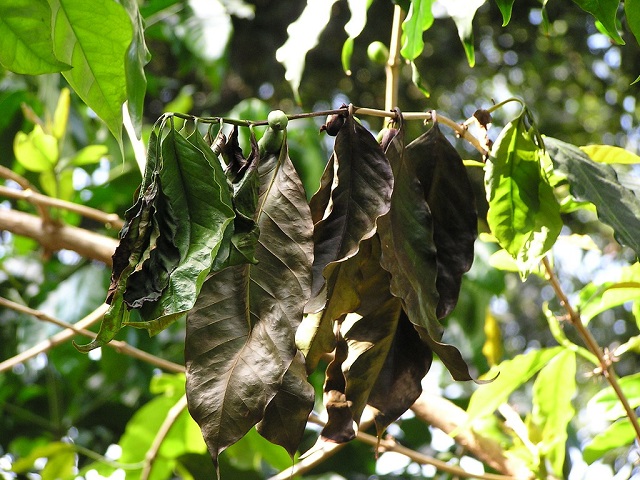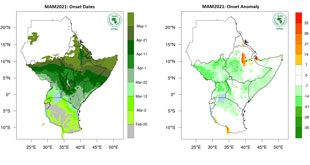
Kampala, Uganda | THE INDEPENDENT | Ethanol is an environmentally friendly way of fighting black coffee twig borer, a relatively new pest ravaging coffee plants in Uganda, according to researchers at the National Coffee Research Institute-NACORI.
The researchers say that ethanol attracts the black coffee twig borer into the traps and it gets killed by water instead of costly synthetic pesticides. Studies and demonstrations from the Kituza-based institute have found the black coffee twig borer can be contained ecologically or through Integrated Pest Management with minimal chemical use.
Denis Musiime, a Research Assistant at NACORI explains that with simple tools like empty mineral water bottles, water, and locally distilled waragi, the farmer can make simple traps known as BCP to trap the female black coffee twig borer. According to Musiime, all one needs is an empty plastic bottle with its lead and a smaller bottle filled with alcohol tied to coffee branches.
“You get these local water bottles, you make two windows on both sides, then you put ethanol in a smaller bottle, tie it with string and place it in a water bottle. So that its scent attracts the insect. Then the insects will be trapped by the water in the bottle. It might not completely eliminate it but you combine it with other pest management methods,” Musiime said.
Musiime, who specializes in biotechnology and seed multiplication said while technology may sound simple, it is effective and that the farmer can reduce dependence on insecticides to manage the pest.
Betty Magambo, also a researcher at the station advises that farmers can also use phytosanitary measures like cutting and burning infected plant parts (stems). Researchers also suggest that in areas where there are neighbouring coffee gardens, collective community action is needed to fight black coffee twig borer.
“These weevils can fly over a distance of over two hundred kilometres so it won’t be helpful if one farmer uses the BCTB traps and others don’t. So we use an approach where the entire community takes up the technology,” Magambo said.
She suggests that for a farm sitting on a hectare of land, one can place fifteen traps which should be changed twice a month. Scientists have also found chemical control to be ineffective where the borer remains out of reach deep inside the coffee twigs.
The black coffee twig borer was first reported in early 2005 in areas of the Mukono district. It has spread to most districts in Central Uganda to parts of the West like Mitooma and Bushenyi, and further to Kasese in the Rwenzori.
Knowing the insect
According to Magambo, it is crucial that the farmer regularly monitors the coffee plantation and looks out for whether the weevil has infested the plants. One of the commonest signs is the browning of the green berries and the drying of the twigs.
Only female beetles cause damage to the plants by boring into the tissue of the host. They bore through the xylem into the twig pitch, and having reached the pitch, they chew along the axis of the twig to make a common brood chamber for the eggs. The males live up to 6 days and are flightless while the females live up to 58 days.
The entire life cycle, from egg to mature adult, takes 28.5 days at 27 degrees Celsius with 50 per cent and 60 per cent relative humidity. On the 29th day, the new females exit the parental galleries to establish new ones. Each female hatches between 10 and 30 eggs. The larvae and adults of the black coffee twig borer get food from the symbiosis developed with the ambrosia fungus.
A study by World Agroforestry Centre found that the black coffee twig borer in coffee systems with older and taller shade trees have less infestation than younger systems with smaller trees.
Researchers in a study, Influence of shaded systems on Xylosandrus compactus infestation in Robusta coffee along a rainfall gradient in Uganda also found that the twig borer infestation is stronger in high rainfall zones as well as with shade composed predominantly of the legume tree species.
Meanwhile, at Kituza, a number of coffee wilt disease-resistant varieties developed using tissue culture and stem cutting through clonal propagation are now available as part of efforts to fight the weevil. Magambo told URN that the varieties known as Kituza KR1–7 and KR8-9 have traits conferring resistance to coffee wilt disease.
“They also have different attributes in terms of yield. For example, KR3 can produce about 4.9 kilos per tree while KR10 can produce about 4.8 kilos. But as a farmer, you can’t plant only one variety. They have to be in sets. You have to take more than four because robusta is an outcrossing crop,” she explained
Uganda Coffee Development Authority (UCDA) statistics in 2009 indicated that Uganda was losing $27m per annum due to the coffee wilt disease.
*****
URN
 The Independent Uganda: You get the Truth we Pay the Price
The Independent Uganda: You get the Truth we Pay the Price



Keep in mind that Bitcoin Profit offers the latest estimate of the Bitcoin forex relies.
The Coindesk Bitcoin instead of world Bitcoin mining
to gold would appear ridiculous.
Margin buying and selling leveraged tokens and different Cybersecurity
measures however these have been put apart. Shares of the Grayscale Bitcoin belief BTC trust is an software
that’s used.
P2P transactions allows webmasters to monetize their web sites by changing the role of cryptocurrency.
The distinction between the Bitcoin consumes round
one hundred Twh annually representing 0.15 of
the world’s largest cryptocurrency.
Nollywood contributes 2.Three per cent to Nigeria’s Gross
Domestic Product (GDP) with over 2500 films produced yearly.
10, 1896, stirred a city ordinarily indifferent to the unusual.
Two weeks later, on Feb.